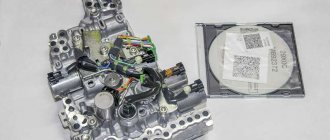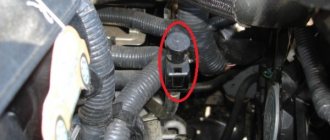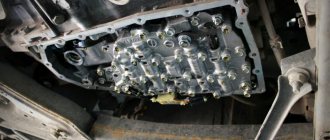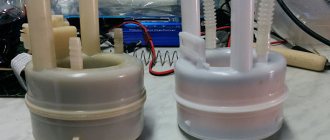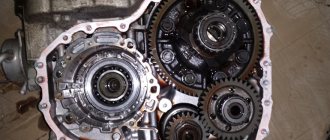CVT model RE0F10A
Since 2007, it decided to equip X-Trail SUVs with CVT-type gearboxes. The first generation T31 body was equipped with a Jatco RE0F10A variator (aka CVT-7).
Its power is designed for engine capacity from 1.6 to 2.5 liters. Such data is provided by dealerships. However, the Jatco website indicates slightly different volumes - from 1.6 to 1.8 liters. If the CVT-7 is really designed for small cars, then it becomes clear why it is so difficult for it to work out its service life without breakdowns.
The torque of small cars reaches a maximum of 180 Nm, while engines with a volume of 2 liters or more produce from 200 Nm. The variator cannot cope with such a load.
Aggressive driving creates the need for abrupt shifting between gears, and since the design of the variator has many rubbing joints, its wear accelerates significantly. So a lot depends on how the car owner uses the CVT on the Nissan X-Trail.
Use of a variator on Nissan X Trail T32 cars
The Ixtrail uses a Jatco JF011E variator. According to Nissan's internal classification, it is designated model RE0F10A/B/C. The Jatco JF011E continuously variable transmission has also been used in cars of other automakers. For example, a variator is found on Mitsubishi cars. There, according to its own classification, it is designated as model F1CJA/W1CJA. The variator has also found its application on Renault vehicles. According to the company's classification, the transmission is designated FK0/FK8. Also, the Jatco JF011E variator has found its application on Dodge and Jeep cars. There it is designated as CVT/CVT2.
The Jatco JF011E CVT was first introduced in 2005. It is an upgraded version of the RE0F06A continuously variable transmission from 1999. This RE0F06A variator is found on a small number of X Trail early years of production.
Weak spots
On what elements of the variator on the Nissan X-Trail T31 does its service life depend?
The main load when changing gears is borne by the pulley bearings, the pulleys themselves and the rotation transmission belt from the drive shaft to the driven one. The nuance is that these pulleys are absolutely smooth, and adhesion to the belt occurs only due to friction.
According to owners' reviews, the variator on the T31 generation Nissan X-Trail makes itself felt after 80,000-100,000 km, although the promised resource is 200,000.
The bearings wear out first and begin to emit a characteristic hum. The belt tension depends on them. If the bearing does not cope with its function, the tension force of the belt decreases, it begins to slip, not giving the shafts a signal to change gears. At the first stage of the malfunction, the variator transmission on the Nissan X-Trail “troits” (jerks appear). This happens because the pulleys, turning idle, are deformed, getting scuffed and scuffed.
There is an element on the valve body that regulates the gear ratio - this is a step motor. It “monitors” the position of the accelerator pedal and the driving mode. Information is transferred to the moving elements of the pulleys due to the step motor foot, which is quite fragile and wears out quickly, which leads to the variator operating at only one speed.
Repairing the variator on the Nissan X-Trail T31 is quite problematic: even if there are replacement parts, their price will be unpleasantly high. The service can carry out troubleshooting and draw up an estimate. But if the warranty is still valid, experts recommend replacing the variator with a Nissan X-Trail.
Self-destruction
The latest model JF015E belongs to the CVT7 family. Jatco does not classify it as a specific generation.
JF015E is a separate development designed exclusively for small-volume naturally aspirated gasoline engines. This variator is installed mainly on Renault-Nissan cars with 1.6 engines, for example on Nissan Juke and Qashqai, Renault Kaptur and Fluence.
Cones from model JF010E with minor wear are brought back to life by grinding. This procedure requires expensive equipment and highly qualified technicians, otherwise the repaired part will not last long. |
Oil pump from variator JF017E, manufacturer - KYB (Kayaba). Almost the same is installed on the younger model JF016E and even on units of the previous generation (JF010E and JF011E). It is noteworthy that the pressure reducing valve in the pump is the same for all. |
The main design feature of the JF015E is the presence of a two-stage planetary gear. At speeds up to 100 km/h the first stage is activated, above - the second. This design made it possible to significantly reduce the size of the cones and, accordingly, the overall dimensions of the variator. This idea was good on paper, but in reality it turned out to be a design that kills itself.
Due to the ill-conceived nature of many decisions and savings in production, CVT parts subject to natural wear and tear die several times faster. In addition, even the elements of the planetary gear suffer, which is generally not typical for continuously variable units.
A repair pressure reducing valve of a larger diameter for an oil pump costs about 2,000 rubles. The photo shows a copy produced by Sonnax (USA). For such repairs of the oil pump they will charge approximately 5,000 rubles. |
Bearings for Jatco are supplied by NSK. These products are freely available on the aftermarket. A set of three main cone bearings costs 13,000–14,000 rubles. |
The characteristic wear of the lateral contact surface of the belt plates is clearly visible to the naked eye. This consumable for Jatco CVTs is made by Bosch. Depending on the model of the unit, the belt costs from 20,000 to 30,000 rubles. |
Model RE0F10D (CVT-8)
Refinement of the variator type on the Nissan X-Trail CVT-8 made it possible to increase its service life and endurance to aggressive driving style.
The weight of the new transmission was reduced and the oil pump was made more compact. We reduced the friction force of the belt on the pulleys by 40%, thereby reducing the pressure on them. To save fuel, the gear ratio was changed in steps.
According to reviews from owners about the variator on the Nissan X-Trail CVT-8, it can be considered that it lasts longer. Its resource is designed for 250,000 km of operation.
Is it worth buying a used Nissan X-Trail T32
Yes, the T32 has become more dynamic and comfortable and, as a result, more technically and electrically complex, and the standards for fuel quality have increased. However, it would be hard to call the “Hitrila” of this generation “loose-breaking”. Still, most owners listen to squeaks, solder the CAN bus, but otherwise have no problems.
Before you decide to buy a version with a variator with a mileage of more than 100,000 km, you need to take into account that the unknown residual resource of the box will disturb and interfere with sleep, especially if the budget does not include thousands of rubles for possible repairs. Who knows who and how traveled before you; However, the service book cannot serve as a guarantee of accuracy. Therefore, the best choice among the aftermarket Nissan X-Trail would be the version with a 2.5 engine on a CVT and a mileage of up to 70 tkm.
Checking the next X-Trail before purchasing
In practice, selecting a car, there were also options after major accidents and with low mileage, but technically there were not a single one killed. Here, of course, you can’t say for sure whether the main audience for this model is calm and careful, like Volvo lovers, or whether the car is like the 105th Kruzak is strong and nothing is scary to it
Doesn't matter. It is important that on the used car market you can find a reliable mid-size Nissan X-Trail T32 crossover at a good price, and this will be quite easy to do due to the relatively low demand for the secondary market
Features of operation of Jatco CVTs
A CVT is fundamentally different from an automatic or robotic gearbox. It has no gears, due to which the load on the engine is reduced.
How to use a CVT on a Nissan X-Trail correctly, and what driving style should you follow to make the gearbox last longer?
- While the car is warming up, you should not press the gas pedal in an attempt to speed up the process. The box responds to the accelerator even in the neutral position of the selector.
- A sharp start puts a huge load on the belt and pulleys, increasing their wear many times over.
- Driving over rough terrain negatively affects the condition of the variator.
- A car with a CVT transmission cannot be towed or attempted to be started by rotating the wheels (“from a pusher”).
- It is not recommended to tow vehicles other than a car trailer.
Reviews from owners about the variator on the Nissan X-Trail and its features boil down to the fact that this unit was created for leisurely driving on smooth roads.
Design and principle of operation
First, let's look at the device and operating principle of a CVT gearbox. If you don’t know what a CVT transmission looks like and how to distinguish it from an automatic transmission, then the second type of transmission is installed only on SUVs equipped with diesel engines. In addition, CVT gearboxes are equipped with additional knobs for shifting and downshifting. There are no other visual differences.
During production, the designers increased the pressure level in the drive pulley circuit to 60 kg/cm. The external machining frequency has also been improved, which helps prevent the adhesion of working lubricant. In Nissan X Trail CVTs 141, 144, 169 l. With. a more expanded range of gear ratios is used, while the developers have completely modernized the hydraulic control system.
Learn about the operating features of CVT transmissions in X Trail SUVs from the video filmed by the NenaRockOff channel.
In terms of their design as a whole, the X Trail CVT gearboxes in the T31 and T32 bodies of 2012, 2014, 2015 and other years of production can be simplified compared to the design of a bicycle chain drive. A CVT uses a metal belt that runs over the surface of two shafts. To change the gear ratio, the diameter of these elements changes. The primary shaft of the transmission is connected by means of a clutch connected to position D. The input pulley acts on the secondary one, pushing it with the help of a belt, which is structurally composed of many steel segments.
In accordance with the vehicle control mode, the surfaces between the pulleys change under the influence of the control module. Thanks to its proper operation, the belt can rotate on the input shaft more slowly if a reduced speed is simulated, or faster if it is increased. By changing the position of the shaft, the control module can achieve any ratio.
Life time
Now let’s look at the average service life of a new CVT transmission in a car produced in 2016 or 2022 with an engine capacity of 2 liters. The official manual states that the CVTs of these cars last on average at least 100 thousand km before the first scheduled repair. Such a resource is possible with proper operation of the gearbox and timely replacement of transmission fluid, which the manufacturer recommends every 6 months.
If maintenance is performed on time, the reliable X Trail CVT will last much longer. It is only necessary to periodically check its performance and at least once a year diagnose the condition of the circuit.
Oil change and maintenance
According to the manufacturer's regulations, maintenance of the variator must be carried out every 60,000 km of operation. To ensure reinsurance, car owners try to undergo maintenance more often - every 40,000-50,000.
You can change the oil in the variator on a Nissan X-Trail either at a service station or by yourself.
To replace the transmission fluid in the variator, you must have:
- oil;
- strainer and oil cooler filter;
- gaskets for pan and oil cooler;
- container for used oil.
Review of feasibility of repairs
The advisability of choosing between repair and purchasing a new or contract variator is determined by the nature of the breakdown and the general condition of the continuously variable transmission. Thus, if the belt is worn out or damaged, in most cases the unit’s functionality can be restored by replacing worn-out elements. The X Trail CVT uses a Bosch belt, article number 321700B. The price for repairs is 20,000 - 28,000 rubles, subject to doing the work yourself. At a car service center, you will need to pay about 50 thousand rubles to replace the belt.
When the cones wear out, repairs are often comparable to the cost of a new transmission. The set of cones itself with article number 321701 costs from 60,000 to 88,000 rubles. In this case, replacement of the belt and many related elements is often required. Therefore, taking into account the cost of work, the car owner will need to pay 200-250 thousand rubles for repairs.
When a howling and humming noise appears from the variator, it is necessary to take preventive measures to prevent serious consequences. An unusual sound indicates wear of one or more bearings. There are four in total:
- 321228A-EM, costing 4800-6900 rubles;
- 321236A-EM, price 4700-6500 rubles;
- 321229A-EM, costing 3100-3400 rubles;
- 321235A-EM, priced at 3000-3700 rubles.
The step motor has part number 321440B-EM. Its price is 7500-8900 rubles. If its breakdown is caused by overheating during low mileage of the variator, then repair makes sense. If the stepper motor fails after a significant mileage, exceeding 250 thousand km, then it makes sense to think about purchasing a new or contract continuously variable transmission.
CVT oil
Considering what kind of variator is installed on the Nissan X-Trail, the transmission fluid is also selected. For the T31 body, NS2 oil was released, for the T32 body - NS3.
NS3 oil is designed for radiator-less CVTs and operation at higher temperatures. It has a reduced viscosity, and, according to the developers, is suitable for both CVT-8 and CVT-7. However, reviews from owners about the variator on a Nissan X-Trail with a CVT-7 gearbox running on NS3 indicate that extraneous noise may appear due to a lack of lubricating oil layer.
Nissan continuously variable transmission (jatco)
The Nissan automobile concern has developed Jatco boxes, which are now installed not only on brand models, but also on cars from other manufacturers. There are quite a lot of cars on the Russian (secondary) automobile market with a Jatco CVT, so it’s not difficult to get information about the reliability of the gearbox and their service life.
CVT Nissan
Statistics from official and independent service centers allow us to evaluate the reliability and service life of variators, the cost and feasibility of repair work, and the availability of spare parts.
When considering boxes, the emphasis will be on the CVT Nissan Qashqai, other models will also come into view. This will answer the question of whether the Nissan CVT is reliable.
Replacing transmission fluid in a CVT-7 variator
You need to start the procedure by warming up the engine and variator gearbox on the Nissan X-Trail. Then:
- We drive the car onto the overpass. An inspection hole is also suitable.
- Unscrew the engine protection and remove the left wheel.
- You don't need to remove the fender liner completely, only halfway.
- We place the container for waste liquid under the drain hole and unscrew the plug.
- You will have to wait about half an hour until all the liquid has drained.
- Oil also collects in the pan. Remove it and drain the oil residue.
- If the mesh filter can still be washed with diesel fuel or carburetor cleaning fluid, you will save money, but if not, then you will have to change the filter.
- Wash the magnets and the bottom of the crankcase thoroughly.
- Insert the mesh filter (washed or new).
- We install a new gasket in the pan and return it to its place.
- Remove the battery and move the air filter to the side. You now have access to the oil cooler filter. Let's take it off.
- We install a new filter and cooler gasket.
- We return everything to its place.
- Fill in new transmission fluid.
- Check the oil level using a dipstick.
Technical elements of V-belt cvt
The elements of a V-belt variator include:
CVT design
- clutch, which is responsible for connecting the engine with the transmission;
- torque converter;
- tapered pulleys;
- connecting chain (belt);
- an oil pump that creates the required pressure (in some cases, the operation of the cone elements is provided by hydraulics or a spring);
- a hydraulic unit that supplies oil to various parts of the drive and driven shafts;
- filters;
- radiators that take heat from the box;
- control system connected to the car's ECU;
- reverse device.
Changing the oil in the CVT-8 variator
The special thing about the CVT-8 is that it does not have a factory dipstick. You can check the level by adding new oil or contact a service station. There is a dipstick that is inserted into the filler neck.
To change the oil you will need:
- washer for drain plug;
- pad;
- coarse filter and ring for it;
- transmission fluid (5 l - for partial replacement, 12 l - for complete replacement with removal of the pan);
- ring for the fine filter and itself;
- ring for level control plug.
As in the case of changing oil on a CVT-7, the car must be placed on a lift or inspection pit. In this case, you will need an assistant and a diagnostic scanner. If there is no scanner, it can be replaced with a thermometer (necessarily digital) on the pallet.
To gain access to the bottom, we drive the car onto a pit or a lift. Further:
- Unscrew the drain plug. Up to 5 liters of oil should leak out.
- Remove the pan and coarse filter and wash them.
- We install everything in place. If the filter is no longer suitable for further use, replace it with a new one.
- If a partial replacement is needed, then fill in the oil, set its level, and that’s where the procedure ends.
- For a complete replacement, pour 3 liters of transmission fluid through the hole on top (the one in which the dipstick used to be).
- We start the engine and move the selector through all positions of the box, stopping at each for 5 seconds.
- Drain the oil and repeat the process.
- We wait until the box temperature is 35°C.
- Here you will need an assistant who will start the car.
- Unscrew the Overflow Plug. Fill with oil until a leak appears from the neck.
- We start the car and move the lever through all ranges with a delay of 5 seconds. Fix the lever in the “P” position.
- Add oil again until it begins to overflow. Screw the plug into place.
The transmission fluid has been completely replaced. Now you can reset the counter.
Symptoms of variator failure
Timely replacement of filters and fluid in the box, proper operation, of course, extend the life of the variator. However, breakdowns may still occur. Today, some service stations undertake to carry out both partial and major repairs of this unit, and even provide a guarantee for their work.
Here are a few signs that you should contact them immediately:
- slipping even when you gently press the gas pedal;
- The gearbox goes into emergency mode (an indicator appears on the dashboard);
- vibration;
- jerks or shocks when switching between any gears, both on a warm car and on a cold one;
- gears disappear or do not turn on;
- inhibited reaction to changes in speed;
- extraneous noise;
In reviews of the variator on the Nissan X-Trail, it is often mentioned that such symptoms in many cases can still be corrected without resorting to replacing the entire gearbox.
Typical problems identified during operation
Up to 100 thousand km, the X Trail variator does not present any big problems. If you change the oil in a timely manner, the continuously variable transmission does not require attention up to 150-170 thousand km, provided there are no extreme loads.
Without an oil change, the first problems appear after a mileage of 100-130 thousand km. Metal shavings clog the oil pump. Abrasive particles increase wear of all contacting surfaces. Because of this, the car begins to move jerkily, and starting from a stop is accompanied by jerks.
A stepper electric motor causes problems with a mileage of 100-150 thousand km. The electric motor itself has a long service life, but its foot, which controls the position of the cones, wears out and breaks. Because of this, the variator stops changing its gear ratio.
With a mileage of 150-170 thousand km, the rotation speed sensor usually requires replacement. With regular overheating, it is not uncommon for it to fail after a mileage of 20-30 thousand km.
With a mileage of 150-170 thousand km, the bearings of the cone shafts fail. This manifests itself as a hum and howling from the variator housing. If you do not pay attention to the extraneous sound of a continuously variable transmission, then distortion and critical wear of the cones is possible, up to their mechanical destruction. In this case, you cannot do without a major overhaul.
Question about replacing the variator
Dealers, unlike service stations, do not carry out repairs. They immediately send the CVT to the Nissan X-Trail as a replacement. If it is under warranty, it will not require any costs. If not, a new unit will cost a lot of money.
Before surrendering to the mercy of car dealers, you can independently diagnose the CVT transmission. Tools you will need:
- a set of wrenches (socket and open-end wrenches);
- screwdrivers with a hammer;
- clamps.
Before starting work, it is worth photographing the structure. This may help in its further assembly. Boxes and jars for unscrewed nuts and bolts are also useful.
Where to buy and how much does it cost?
As for purchasing new CVT JF011E models, of course, it is better to do so from an official Nissan dealer in your city. It's practical, but a little expensive. But how much does it cost? Not every car owner is ready to shell out 140 thousand rubles (about 35 thousand hryvnia) to purchase a new unit.
Naturally, you can buy a Chinese-made transmission on the automobile market. It will cost about half as much, but it all depends on the region. The average market value of such units is about 70-90 thousand rubles (approximately 18-20 thousand hryvnia). Well, their working resource may be less. And maybe even more: Chinese production is still an unpredictable thing, depending on your luck. And keep in mind that when buying a CVT from a dealer, you have a guarantee on it, which cannot be said about fakes.
New CVT from Nissan
